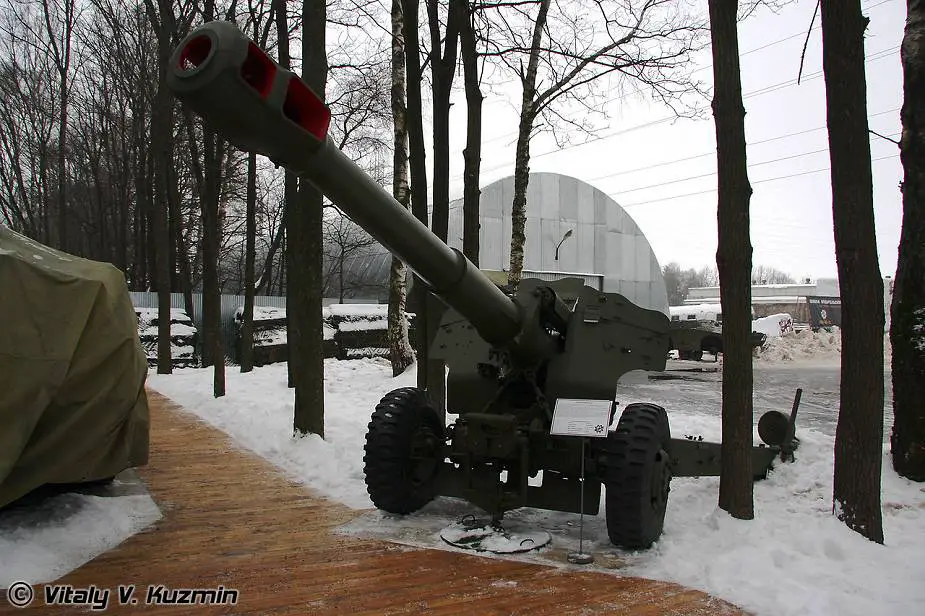- Army
- Conflicts in the world
- Israel - Iran conflict 2025
- Pakistan - India Conflict 2025
- Russia Ukraine War 2022
- Libya conflict day by day
- HAMAS - Israel War 2023
- Operation Serval in Mali French Army
- Sangaris operation Central African Republic
- Sangaris opération militaire République Centreafrique
- Ukraine - Russia conflict
- Syria conflict news
- Defence & Security Industry Technology
- Armies in the world
- Analysis Defense and Security Industry
- Conflicts in the world
- Navy
- Air
Russia Enhances D-20 152mm Howitzer Accuracy with UAVs to Target Ukrainian M2A2 Bradley IFV
According to information and video released by the Russian Ministry of Defense on July 15, 2023, Russian forces have been utilizing the older D-20 152mm towed howitzer in conjunction with Unmanned Aerial Vehicles (UAVs) to increase targeting accuracy. This novel tactic has allowed the D-20 to precisely target and destroy the M2A2 Bradley Infantry Fighting Vehicles (IFVs), providing high-precision fire.
Follow Army Recognition on Google News at this link

Russian artillery unit deployed in Ukraine uses an old Soviet-made 152mm towed howitzer in conjunction with Unmanned Aerial Vehicles (UAVs) to increase targeting accuracy and destroy Ukrainian M2A2 Bradley IFV. (Picture source Russian MoD)
The D-20 is a 152.4mm towed gun-howitzer that was developed in the Soviet Union after World War II. Created by the design bureau led by F. F. Petrov, the gun was produced from 1955 to 1987. The design of the D-20 allows for a high degree of accuracy and a respectable range, making it a powerful asset on the battlefield.
Drones, also known as Unmanned Aerial Vehicles (UAVs), are a game-changer for improving the accuracy of artillery systems like the D-20 howitzer. They serve as the eyes in the sky for artillery units, providing them with unprecedented access to real-time, high-resolution imagery of the battlefield. This enables far more accurate target acquisition than was previously possible.
Firstly, drones excel in scouting and identifying potential targets. Equipped with state-of-the-art surveillance technologies, drones can scan wide areas and pinpoint enemy positions, even those hidden from ground observers. This real-time information is relayed back to the artillery units, allowing them to align their howitzers accurately.
Once the artillery is fired, drones play another crucial role. They can observe the impact of the artillery and determine whether the rounds have hit the intended target. This is known as Battle Damage Assessment (BDA). In cases where the target is not neutralized, the drone can relay information about the missed target's location, allowing the artillery unit to make necessary adjustments for subsequent shots.
Moreover, by continually monitoring the battlefield, drones can alert artillery units to the movement of enemy forces. This means the D-20 howitzer can respond to changing battlefield conditions far more effectively than before.
Thus, by integrating drone technology, the capabilities of older artillery systems like the D-20 howitzer can be significantly enhanced, increasing their precision and overall effectiveness in modern warfare.
The D-20 marked a milestone as the first 152-mm towed howitzer featuring a semi-automatic wedge bolt with a vertical movement design. This artillery piece continues to serve in no less than 13 nations worldwide, and its production was replicated under license in China, where it's known as the Type 66 (or an enhanced version named the Type 66-1). An iteration of the Surface-to-Air Missile (SAM) system based on the D-20, named Type 83, debuted in the mid-1980s.
In terms of ammunition, the D-20 is capable of firing various types of rounds, such as fragmentation, High-Explosive Fragmentation (HE-FRAG), High Explosive (HE), concrete-breaking, and illumination shells. Furthermore, it can launch Krasnopol laser-guided munitions, as well as nuclear projectiles. The maximum firing range for a HE-FRAG round is 17.4 km. Moreover, an HE round can penetrate a 250 mm steel plate from a distance of 3 km.

The D-20, a Soviet-origin towed howitzer, was devised in the early 1950s to supersede most of the 152mm howitzers in Soviet service. (Picture source Vitaly Kuzmin)
News Russia Ukraine War


























